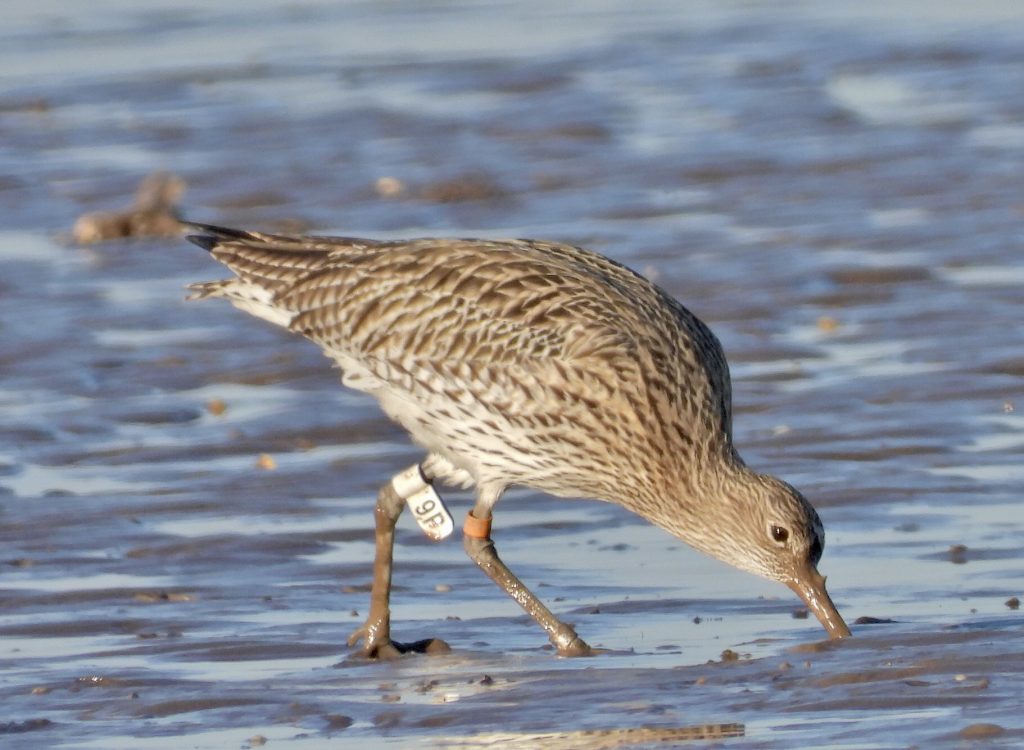Curlew, a Near Threatened species, are a major feature of The Wash where they occur in nationally important numbers. They are declining throughout their range and, in the UK: the 25-year (to winter 2019–20) population trend for Curlew is -33% and the 10 year -18%. We see them feeding on both the tidal mudflats and on the inland fields, where they eat earthworms.
Over the last few years, we have begun to add more to our knowledge of the movements of Curlew by using coloured leg flags so that we can identify an individual without re-catching it. This has taught us more about which Curlew use the inland fields around The Wash to feed and when they do so. More recently, we have gone a step further and equipped a few birds with GPS/GSM tags which allow us to track their movements in much more detail. There is also much interest in the more-distant movements of Curlew, however, as they leave The Wash and head off to their breeding grounds. For Wash Curlew this means crossing the North Sea (and for some the Baltic) heading east on their way to Sweden, Finland, or even Russia.

There are many potential dangers for a bird crossing the North Sea, and the risks have increased as more and more offshore windfarms (OWF) are being installed as we try to move towards renewable energy sources; however, we know relatively little about the chance of birds colliding with, or being displaced as they avoid, windfarms. To address this, Philip Schwemmer and colleagues brought together data from Curlew tagged in seven countries across Europe consisting of 259 migration tracks for 143 Global Positioning System-tagged birds recorded over six years (including data from The Wash birds – 10 tracks in autumn and 10 in spring). The data were used to look at how individuals respond when approaching OWFs in the North and Baltic Seas at two different spatial scales (i.e., within 3.5 km and up to 30 km distance). They found small but significant increases in flight height (particularly within 500 m of an OWF) and changes in horizontal movements as birds tried to avoid turbines. Overall, they estimated that about 16% of Curlew were at increased risk during autumn migration and about 6% at increased risk in the spring (when wind conditions mean their flight heights overlapped with rotor levels far less).
This work has showed how Curlew make small-scale movements to avoid OWF, which is good as it is likely to reduce collision risk. However, it also shows the substantial barrier effects of OWFs and, given the massive ongoing construction of new OWFs, emphasizes the urgent need to quantify the energy costs to birds of avoiding rotors during what must be an arduous flight.
While we will be looking at habitat use from data collected from the Curlew we have tagged on The Wash, we will continue to look for opportunities to work with others to further increase the value of our data and contribute to the conservation of this iconic species.
Paper:
Philipp Schwemmer, Moritz Mercker, Karena Haecker, Helmut Kruckenberg, Steffen Kämpfer, Pierrick Bocher, Jérôme Fort, Frédéric Jiguet, Samantha Franks, Jaanus Elts, Riho Marja, Markus Piha, Pierre Rousseau, Rebecca Pederson, Heinz Düttmann, Thomas Fartmann & Stefan Garthe. (2023) Behavioral responses to offshore windfarms during migration of a declining shorebird species revealed by GPS-telemetry. Journal of Environmental Management 342: 118131.

